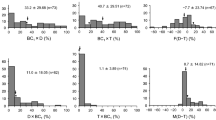Treatment of plants of 3 self-incompatible chrysanthemum clones for 12, 24 and 48 h periods at 30, 35 and 40 °C greatly influenced self- and cross-seed yield as compared to a control held continuously at 16 °C N and 21 °C D. Seed yield following cross pollination was generally not significantly different from the cross control when plants were treated at 30 and 35 °C but nearly always was adversely influenced by 40 °C regardless of the treatment length. In 4 treatments selfed-seed yield on clone 67-111-42 approached or slightly exceeded 50% of that of a high yielding corresponding cross pollination. Selfed-seed on the other 2 clones did not, however, exhibit a similar response. Three of 14 clones which were either sibs of 64-111-42 or derived from matings between 67-111-42 and its sibs and selfed progeny were classified as self compatible when heat treated at 35 °C for 24 h. Plants of 4 progenies from reciprocal crosses between a heat sensitive clone and two heat insensitive clones were similarly evaluated and 14 out of 112 plants were classified as self compatible.
Similar content being viewed by others
References
Drewlow, L. W., 1971. Incompatibility in the garden chrysanthemum, Chrysanthemum morifolium. PhD. Thesis. University of Minnesota. 82 pp.
El Murabaa, A. I. M., 1957. Effect of high temperature on incompatibility in radish. Euphytica 6: 268–270.
Hecht, A., 1964. Partial inactivation of an incompatibility substance in the stigmas and styles of Oenothera. In: H. F., Linskens (Ed.), Pollen physiology and fertilization. North Holland Pub. Co., Amsterdam, pp. 237–243.
Johnson, A. G., 1971. Factors affecting the degree of self-incompatibility in inbred lines of Brussels Sprouts. Euphytica 20: 561–573.
Ling, L., R. E., Widmer & R., Mullin, 1966. Influence of temperature, nutrition and combining ability on seed production in chrysanthemum. Proc. Am. Soc. hort. Sci. 88: 621–626.
Ronald, W. G. & P. D. Ascher, 1974. Self compatibility in garden chrysanthemum: occurrence, inheritance and breeding potential (manuscript for submission to Theor. appl. Genet.).
Sampson, D. R., 1957. The genetics of self- and cross-incompatibility in Brassica oleracea. Genetics 42: 253–263.
Townsend, C. E., 1965. Seasonal and temperature effects on self-incompatibility in tetraploid alsike clover, Trifolium hybridum. Crop Sci. 6: 329–332.
Townsend, C. E., 1966. Self-compatibility response to temperature and the inheritance of the response in tetraploid alsike clover, Trifolium hybridum L. Crop Sci. 6: 409–414.
Townsend, C. E., 1971. Further studies on the inheritance of a self-compatibility response to temperature and the segregation of S alleles in diploid alsike clover. Crop Sci. 11: 860–863.
Author information
Authors and Affiliations
Additional information
Scientific journal Series Paper Number 8758 of the Minnesota Agricultural Experiment Station.
Rights and permissions
About this article
Cite this article
Ronald, W.G., Ascher, P.D. Effects of high temperature treatments on seed yield and self incompatibility in chrysanthemum. Euphytica 24, 317–322 (1975). https://doi.org/10.1007/BF00028196
Received:
Issue Date:
DOI: https://doi.org/10.1007/BF00028196




